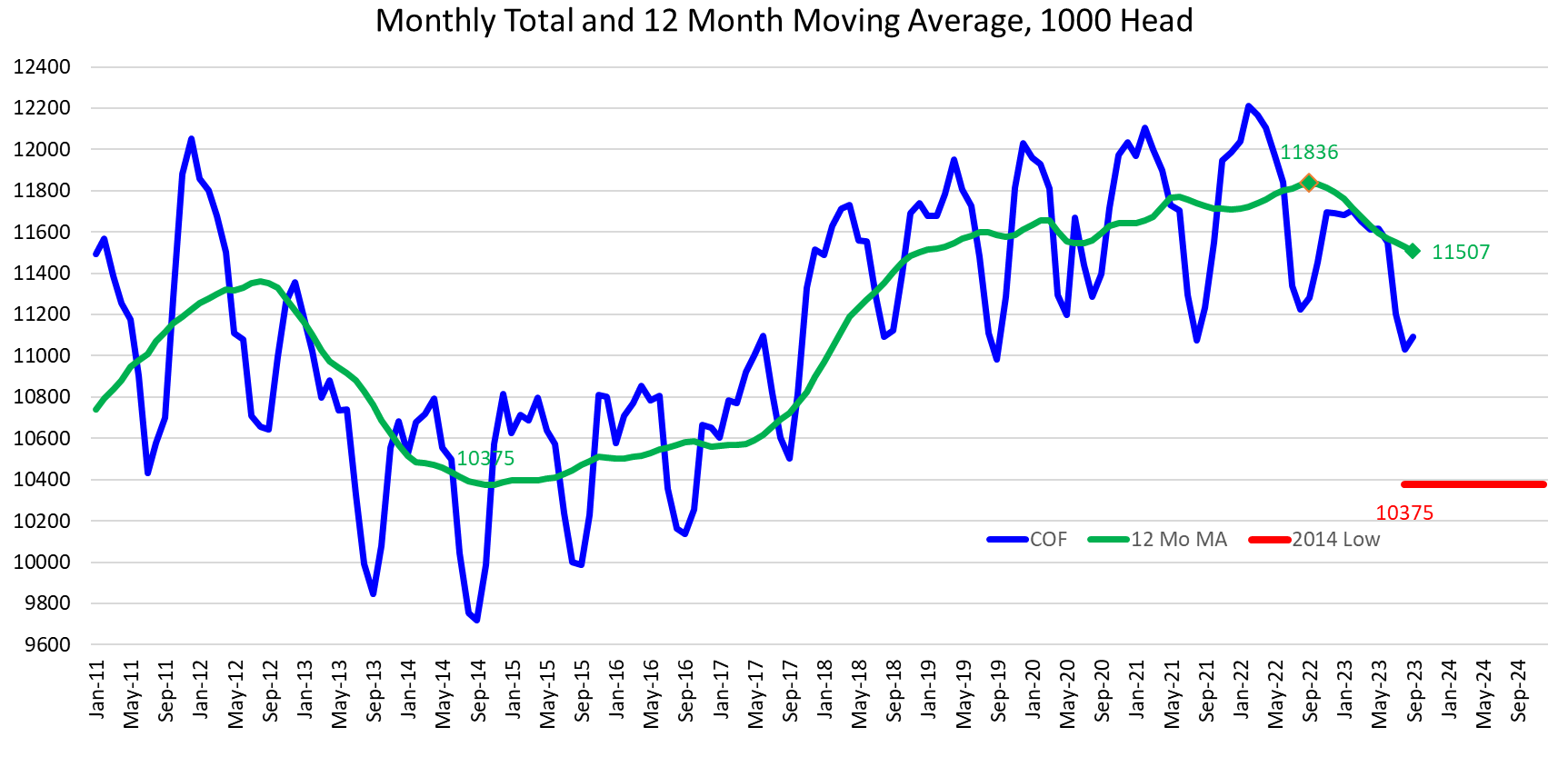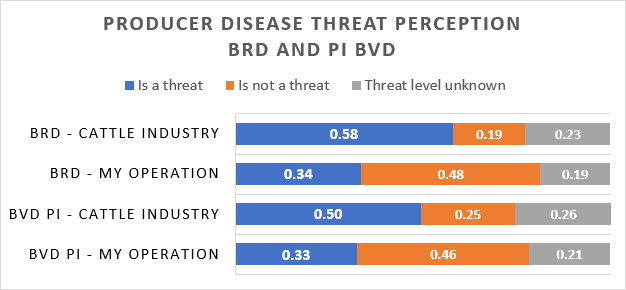Cow-Calf Corner | September 25, 2023
Feedlot Inventories Slowly Diminish
Derrell S. Peel, Oklahoma State University Extension Livestock Marketing Specialist
The latest USDA-NASS Cattle on Feed report pegs the September 1 feedlot inventories at 11.094 million head, down 2.2 percent year over year. The September feedlot total was up slightly from the August summer low, which was the lowest monthly on-feed total since September of 2019. Feedlot inventories have been lower year over year for the past twelve months.
Figure 1 shows monthly feedlot totals and a 12-month moving average, which provides a good measure of the underlying trend for the past year. The 12-month moving average peaked in September 2022 at 11.836 million head. The September 2023 12-month moving average is 11.507 million head, down 2.8 percent from the peak. Figure 1 also shows the 2014 cyclical low of 10.375 million head, a likely target for feedlot inventories in the coming months. Following the drought a decade ago, the 12-month moving average dropped below 11 million head in April 2013 and remained below that level for 58 months through January 2018. This was the period of rapid herd expansion in the last cattle cycle and a similar situation is likely going forward, beginning in 2024.
Figure 1. Cattle on Feed
Monthly feedlot placements in August were down 5.1 percent year over year; the lowest August placements since 2019. Placements have decreased year over year for ten of the last twelve months, with total placements down 897 thousand head in the last year. A 12-month moving average of placements shows that the peak annual average monthly placements occurred in December 2019, consistent with the cyclical peak in the calf crop in 2018. However, pandemic delays from 2020 into 2021and drought enhanced placements in 2021 and 2022 have kept feedlot placements high until the last few months. The current 12-month moving average of placements for August just dropped to the lowest level since May of 2017. Average placements are expected to continue declining for the foreseeable future.
Feedlot marketings in August were down 6.0 percent year over year. Total marketings for the year to date are down 3.4 percent. Feedlot marketings are, of course, highly correlated with slaughter. Monthly feedlot marketings are 90 percent correlated with yearling (steer plus heifer) slaughter and account for an average of 86.6 percent of monthly federally inspected steer and heifer slaughter. Marketings from small feedlots, with less than 1000 head capacity, make up the difference. Yearling slaughter for the first eight months of the year is down 3.2 percent year over year. The year over year decrease in yearling slaughter consists of a 4.9 percent year-to-date decrease in steer slaughter and a 1.1 percent year-to-date decrease in heifer slaughter.
Heifer retention is expected to increase sharply at some point in the coming months which will drop the number of heifers in feedlots and decrease heifer slaughter. The July quarterly data showed that heifers currently make up 39.9 percent of feedlot inventories. When heifer retention begins in earnest, this percent will drop to about 32 percent. This suggests that average feedlot inventories will likely drop another 1.0 - 1.2 million head at least in the next 8-18 months. Feedlot inventories will likely decline to a level close to the 2014 low in Figure 1 and stay relatively low for many months.
Derrell Peel, OSU Extension livestock marketing specialist, says the cattle market should remain strong into the fall on SunUpTV from September 16, 2023.
Beef Quality Assurance
Breeding Specialist and Barry Whitworth, Senior Extension Specialist/Oklahoma BQA Coordinator
Beef Quality Assurance (BQA) is a nationally coordinated, state implemented program that provides systematic information to U.S. beef producers and beef consumers of how common-sense animal husbandry techniques can be coupled with scientific knowledge to raise cattle under optimum management and environmental conditions. BQA guidelines are designed to make certain all beef consumers have confidence in the entire beef industry. The BQA program is a producer-driven certification program designed to assure consumers that cattle from all industry segments (cow-calf, stocker, feedlot) are healthy, wholesome and have been produced under the best management practices in the cattle industry. When beef producers become BQA certified it sends a message to consumers that they are willing to take the management steps necessary to produce a quality product.
The BQA program is voluntary. There is no requirement for cow-calf or stocker operations to be certified unless they sell calves into a premium or branded program that includes BQA certification as a requirement. As discussed last week in Cow-Calf Corner, the Oklahoma Quality Beef Network (OQBN) does require producers to be BQA certified. Accordingly, while certification is not required for cow-calf or stocker operations, it can open the door to increased profit potential. Most packers require fed cattle they purchase be sourced from BQA certified operations, not surprisingly, nearly all feedlots are BQA certified.
The BQA program focuses on the following management areas:
- Care and management practices
- Feedstuffs
- Feed additives and medications
- Processing, treatment and record-keeping
- Injectable animal health products
Producers interested in becoming BQA certified have two options. The certifications process can be completed on-line at http://www.bqa.org/ where the process will include several modules followed by short quizzes. In-person certification is also available. The in-person training consists of a presentation followed by a short quiz. If you are interested in the in-person certification, contact your local OSU Extension office to find out when in-person certification is available in your area or visit the link below. Certification is valid for three years. At the end of three years, producers can re-certify by going through the same process as the initial certification. Dr Barry Whitworth is the Oklahoma BQA Coordinator. Dr Whitworth can be reached at (580) 332-7011 or by email.
Reference
Oklahoma Cow-Calf Producer Perceptions of BRD and BVD-PI Threats
Kellie Curry Raper and Amy Hagerman, OSU Department of Agricultural Economics, State Extension Specialists
The Oklahoma Cow-Calf Biosecurity was implemented in early 2022 to gain insight into biosecurity practices on Oklahoma cow-calf operations. The survey was administered for OSU through USDA National Agricultural Statistics Service (NASS) and garnered over 1400 producer responses. The overarching goal of the survey is to find ways to increase producer awareness of biosecurity issues and to assist producers in planning and implementation of best practices with respect to biosecurity on their individual operations.
One constant for cattlemen is considering the potential threat and impact of infectious diseases. A segment of the survey asks producers to rate the threat level of Bovine Respiratory Disease (BRD), commonly known as shipping fever or pneumonia, and the threat level from Persistently Infected (PI) Bovine viral Diarrhea (BVD PI) cattle, recognizing that BVD is part of the larger BRD disease complex. BVD PI animals can be a problem for producers because they are BVD carriers that constantly shed the virus creating consistent viral exposure to other members of the herd. The survey asks producers to rate the threat of these diseases to: (1) their own operations due to arrival of cattle from outside sources, and (2) the beef industry overall. Those results are reported in Figure 1.
When asked whether BRD is a threat to the industry, 58% of producers perceive that it is a threat to the industry. Only 19% of producers state that they do not believe it is a threat, while 23% are not sure whether it is a threat. In contrast, only 34% believe that BRD is a threat to their own operation, but 48% - nearly half of producers responding - believed that BRD is not a threat to their own operation. Producer evaluation of the perceived threat from BVD PI cattle is similar. Half of survey respondents believe that persistently infected BVD PI cattle are a threat to the industry, with 25% responding that it is not a threat to the industry. However, when asked whether BVD PI cattle are a threat to their own operation, only 33% say that it is a threat and nearly half (46%) say that it is not. In both scenarios, only a small percentage of producers are unsure of the threat to the operation or are unfamiliar with the disease. Interestingly, for both BRD and BVD PI, producers perceive that the threat of disease is a greater threat to the industry than it is to their own cattle operations.
There may be multiple reasons that cattlemen perceive a greater threat of disease to the industry than to their own cattle. On the one hand, producers may have biosecurity elements in place that they feel are sufficient protection against BRD and BVD for their cattle and operation. Quarantines for incoming cattle, a closed herd, and vaccinations for the herd and calves are all elements that can protect against disease. On the other hand, some cattlemen may simply have unrealistic perceptions of disease threats. So how do we sort that out? For example, are perceived threats greater or smaller based on herd size? How does the number of biosecurity practices already in place impact perceptions of disease threat? Stay tuned! But as you wait for more information on the topic, consider your own perceptions about disease threats and what it is that informs your decisions regarding biosecurity on your operation.
OSU Extension beef cattle specialist Rosslyn Bigs discusses the importance of practicing safe biosecurity with livestock during the fair season on SunUp TV from September 25, 2021.
Join the Resilience in Agriculture - Cultivating Healthy Minds webinar



